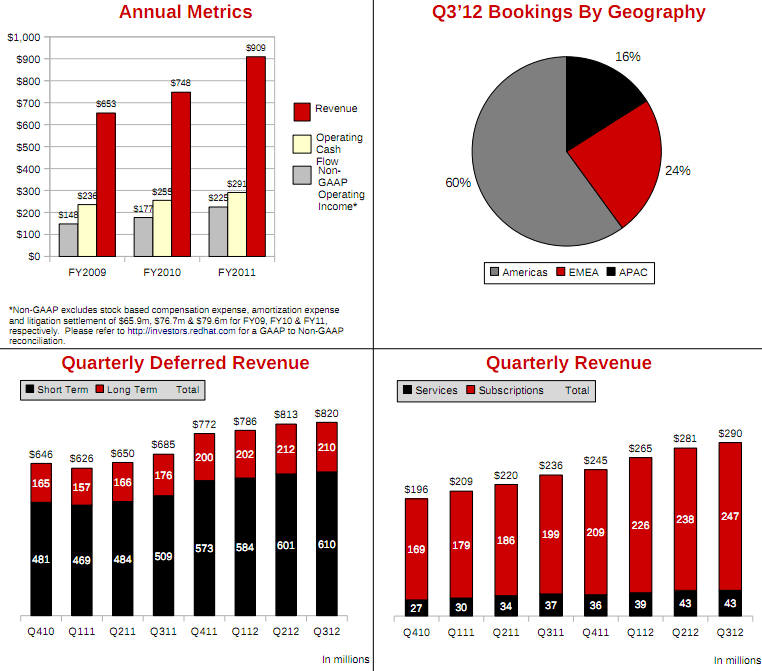Few software companies reach $1 billion in annual revenue. No company has done it with a portfolio that consists entirely of open source software. But if Red Hat delivers the expected results in early 2012, it will prove that a company can do right by the open source community and its investors. Given the 2011 third quarter results announced by Red Hat on December 19th, it’s looking very likely.
 On Monday, Red Hat posted its results for the quarter ending on November 30th. Red Hat’s fiscal year runs March to February.
On Monday, Red Hat posted its results for the quarter ending on November 30th. Red Hat’s fiscal year runs March to February.
For the last quarter, Red Hat earned $290 million in revenue with a GAAP operating income of $54 million. Once again, it’s all up for Red Hat — the revenue is up 23% year-over-year, and the GAAP income is up 41% over last year.
It’s no accident nor is it just a lucky year. If you look over the last few years, Red Hat has been on a steady climb. It earned $653 million in its 2009 fiscal year, $748 million in 2010, and has already pocketed $909 million in 2011.
Most of Red Hat’s money comes from subscriptions, $247 million of the $290 this quarter, but Red Hat is also earning a fair amount from services ($43 million).
Breaking the $1 Billion Barrier
Unless something really drastic happens, Red Hat will sprint past the $1 billion mark for its 2011 fiscal year. Obviously, this is an important milestone for Red Hat, but why does it matter outside the company?
For one thing, Red Hat’s success bodes well for the larger Linux community. It means the company continues to develop open source software, contribute to upstream communities like the Linux kernel, and drive innovation in open source.
It means continued support for the Fedora Project, which is an important community for Linux. Even if you’re not a Fedora user, what happens in Fedora doesn’t stay in Fedora. A lot of work happens in Fedora first and then makes its way to other Linux distributions. (Which is not to say that isn’t true of other community distros, of course.)
It also means pushing “open” to the next level when it comes to virtualization and cloud computing. Red Hat is pushing hard on KVM virtualization, and its Infrastructure-as-a-Service (IaaS) CloudForms and Platform-as-a-Service (PaaS) OpenShift. Instead of shying away from cloud computing as “dangerous,” Red Hat is doing its level best to ensure there’s an open alternative. (And make a business out of it, of course.)
Next?
The most important thing is that Red Hat proves its possible to forge a billion dollar business without being “open core,” or having proprietary licensing mixed in. Red Hat consistently open sources everything. When it acquires companies that have proprietary code, it eventually open sources that as well. (Note that this can be a complicated process – and it’s not instant.)
You might think that Red Hat has succeeded despite the “handicap” of having its primary product available as open source. I’d say that Red Hat has succeeded because of it. Red Hat has had to work harder and continue innovating to stay ahead of the competition and convince customers that they should pay for Red Hat subscriptions and service. But it has done it. The one-billion mark is proof.
Red Hat will be the first pure open source play to break the billion dollar barrier, but I don’t think it will be the last. Some folks suggest that few open source companies will get to the $1 billion mark.
Why? The economics are difficult, because open source companies tend to be disruptive and produce less revenue than proprietary companies. That is, they produce less revenue for the proprietary company themselves – I’d argue that Red Hat is at the center of a lot more value than the $1 billion-plus it will take in in FY2011.
But difficult isn’t impossible, and if you’d asked around in 2001 if a company like Red Hat could pull down $1 billion a year, few would have said yes. Red Hat demonstrates it is possible, and shows how it’s done.


